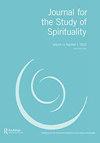A tipping point? Spirituality in a time of meta crisis
IF 0.8
0 RELIGION
引用次数: 0
Abstract
When I first began to think about this Editorial, I was side-tracked by a message from a neighbour who teaches in a primary school (children aged 5–11). As part of their work on number she encourages her pupils to look for patterns in dates. That morning they had been very excited to find that it was a ‘Palindrome Day’. It was the 22nd of February and, because dates are written in the UK in day-month-year order, the sequence was 22 02 2022 – a sequence which is exactly the same when read both backwards and forwards. Technically a ‘single repetitive integer with zero’, this kind of palindrome date first appeared on 11 January 1011; there will not be another in our lifetimes. Written in the angular font which is often used on digital devices, 22022022 also forms an ambigram since it looks the same upside down. When I later drew my own young granddaughter’s attention to the phenomenon, she pointed out the coincidence that it was a Tuesday, the 2nd day of the week. She delightedly dubbed it ‘Super Twosday’! The unusual nature of the date was even acknowledged on the BBC’s Ten O’Clock News – at 22 minutes 22 seconds past 22.00 hours! I mention all this because, ironically, just two days later, on 24 February, Vladimir Putin ordered Russian troops to invade Ukraine, a sovereign state in Eastern Europe with a population of over 43 million. It is the second-largest country by area in Europe after Russia, which it borders to the east and north-east. Since then all such trivia as the shape of a date has been wiped from our news screens and replaced by horrific scenes of devastation – of towns razed to the ground by relentless aerial bombardment; of millions of women, children and elderly people fleeing the country in whatever way they can, often with only small hastily-packed bags, leaving their husbands, fathers, sons and brothers behind to fight for the survival of their country; and of people forced to remain in basements, held under siege in cities deprived of water, food and power – in every sense of that word. I entitled my Editorial in issue 10.2 of this journal ‘The best of times, the worst of times?’ (Hunt 2020). It was written at the height of the coronavirus pandemic which, although vaccines are now available and help to mitigate its worst effects, continues to afflict millions of people around the world. I questioned whether the pandemic might have brought us to a long-predicted tipping point in human affairs – a time of ‘breakdown or breakthrough’ (Myers 1990, 180). The predicted breakdown is of the belief that we live in a ‘clockwork universe’. This image has held sway over Western philosophical, political and scientific developments since the seventeenth century (Dolnick 2012). It has created a mindset in which reality is ‘out there’ in a material world of引爆点?meta危机时期的精神
当我第一次开始考虑这篇社论的时候,我被一个在小学(5-11岁的孩子)教书的邻居发来的信息转移了注意力。作为学习数字的一部分,她鼓励学生们寻找日期的规律。那天早上,他们非常兴奋地发现今天是“回文日”。那天是2月22日,因为在英国,日期是按日-月-年的顺序书写的,所以日期序列是22 02 2022——无论向后还是向前读,这个序列都是完全一样的。从技术上讲,这是一个“带有零的单个重复整数”,这种回文日期首次出现在1011年1月11日;在我们的有生之年不会再有这样的事了。用数字设备上常用的角字体书写,22022022也形成了一个双义图,因为它倒过来看起来是一样的。后来,当我把我的小孙女吸引到这个现象时,她指出这是一个巧合,那天是星期二,一周的第二天。她高兴地称之为“超级星期二”!英国广播公司的“十点新闻”甚至在22点22分22秒的时候承认了这一不寻常的日期!我之所以提到这一切,是因为具有讽刺意味的是,仅仅两天之后,即2月24日,弗拉基米尔·普京下令俄罗斯军队入侵乌克兰,一个拥有4300多万人口的东欧主权国家。按面积计算,它是仅次于俄罗斯的欧洲第二大国家,其东部和东北部与俄罗斯接壤。从那时起,所有诸如日期形状之类的琐事都从我们的新闻屏幕上消失了,取而代之的是可怕的破坏景象——城镇被无情的空袭夷为平地;数以百万计的妇女、儿童和老人以各种可能的方式逃离该国,往往只带着匆忙打包的小包,留下丈夫、父亲、儿子和兄弟,为国家的生存而战;人们被迫留在地下室,被围困在城市里,被剥夺了水、食物和电力——在任何意义上都是如此。我在《华尔街日报》第10.2期的社论题为《最好的时代,最坏的时代?》(Hunt 2020)。这篇文章是在冠状病毒大流行最严重的时候写的,尽管现在有了疫苗,并有助于减轻其最严重的影响,但全球仍有数百万人受到影响。我质疑大流行是否可能将我们带到了人类事务中一个长期预测的转折点——一个“崩溃或突破”的时刻(Myers 1990,180)。预测的崩溃是相信我们生活在一个“发条宇宙”中。自17世纪以来,这一形象一直影响着西方哲学、政治和科学的发展(Dolnick 2012)。它创造了一种心态,在这种心态中,现实是“在那里”的物质世界
本文章由计算机程序翻译,如有差异,请以英文原文为准。
求助全文
约1分钟内获得全文
求助全文
来源期刊

Journal for the Study of Spirituality
RELIGION-
CiteScore
2.50
自引率
7.10%
发文量
25
期刊介绍:
Journal for the Study of Spirituality is a peer-reviewed journal which creates a unique interdisciplinary, inter-professional and cross-cultural forum where researchers, scholars and others engaged in the study and practices of spirituality can share and debate the research, knowledge, wisdom and insight associated with spirituality and contemporary spirituality studies. The British Association for the Study of Spirituality (BASS) organises a biennial international conference and welcomes enquiries about membership from those interested in the study of spirituality in the UK and worldwide. The journal is concerned with what spirituality means, and how it is expressed, in individuals’ lives and communities and in professional practice settings; and with the impact and implications of spirituality in, and on, social policy, organizational practices and personal and professional development. The journal recognises that spirituality and spiritual values can be expressed and studied in secular contexts, including in scientific and professional practice settings, as well as within faith and wisdom traditions. Thus, Journal for the Study of Spirituality particularly welcomes contributions that: identify new agendas for research into spirituality within and across subject disciplines and professions; explore different epistemological and methodological approaches to the study of spirituality; introduce comparative perspectives and insights drawn from different cultures and/or professional practice settings; aim to apply and develop sustained reflection, investigation and critique in relation to spirituality and spiritual practices; critically examine the values and presuppositions underpinning different forms of spirituality and spiritual practices; incorporate different forms of writing and expressions of spirituality.
 求助内容:
求助内容: 应助结果提醒方式:
应助结果提醒方式:


